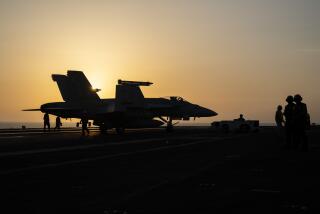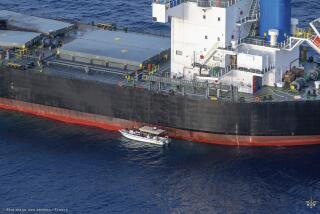U.S. Fax Supplied Details Before Cole’s Visit
- Share via
ADEN, Yemen — Three days before terrorists lowered their 20-foot, cream-colored boat into the water near Little Aden’s Khaldin Bridge last month and headed for the U.S. warship Cole, copies of a fax arrived in at least two Yemeni civilian offices at the harbor.
One copy of the fax, which announced key operational details of the guided missile destroyer’s visit, was sent to the port’s harbor master. Another went to Gulf of Aden Shipping Co., the Yemeni commercial contractor used by the U.S. Navy to haul away ships’ garbage, pump out sewage and supply provisions.
The fax--sent by officials at the U.S. Embassy in Sana, the Yemeni capital--noted the exact time the $1-billion ship was to arrive for berthing at Refueling Bunker No. 7 in the inner harbor and the five to six hours it would remain here to load 200,000 gallons of fuel, empty hundreds of gallons of sewage and offload hundreds of pounds of garbage onto local scows.
The fax suggests that by the time the Cole steamed into the Port of Aden on Oct. 12 at the appointed time of 8 a.m., dozens of Yemeni port workers, garbage haulers, sewage disposers and their friends knew as much or more about the Cole’s refueling stop as did the 26 U.S. officers and 270 enlisted personnel on board.
And they knew it well before the destroyer finished mooring in the inner harbor at 9:30 a.m.--nearly two hours before the small boat apparently mistaken for a local garbage scow blew a 40-by-40-foot hole in the ship’s hull.
But that, Yemeni officials say and documents here show, was standard operating procedure for the two dozen or so U.S. warships that preceded the Cole for refueling and garbage disposal in Aden during the past 18 months.
These details of the Cole’s visit, which left 17 U.S. sailors dead and 39 injured, were culled from documents and interviews with Yemeni officials and witnesses here since the attack.
They appear to raise further questions about the Navy’s security procedures at a time of heightened alert in the region and in a nation the Pentagon knew was a “soft spot” for anti-American terrorists. The procedures are now under scrutiny by Congress and a Defense Department fact-finding commission.
Yet the details shed little light on whether the Cole attack was a home-grown plot hatched by Yemeni extremists or the work of foreign infiltrators, as Yemeni President Ali Abdullah Saleh has suggested.
In fact, documents here show that even an outsider could have had ample opportunity to gather detailed intelligence on the Cole’s likely procedures in Aden weeks before the bombers immobilized the warship.
In announcing initial findings Oct. 18 of Yemen’s investigation, Saleh said the bombers had been preparing for their attack for six to eight weeks. During that time, they easily could have watched other U.S. warships come and go in the Port of Aden.
The logbook at the harbor master’s office recorded the visit of an almost identical Arleigh Burke-class destroyer, the Barry, on Aug. 26, followed by another destroyer two days later. The Barry’s refueling and servicing operations in Aden’s inner harbor were done, as always, in full view of shore.
What is more, Yemeni security officials have identified one of the five houses that the Cole’s bombers allegedly used here as a lookout point, where investigators found binoculars and an unobstructed view of the approach to Aden’s harbor.
Yemeni officials stressed this week that their nation’s underfunded navy, which has a permanent presence in the port, bears no responsibility for securing the Cole, nor any of the foreign warships that call in Aden. Ultimately, that responsibility lies with the visiting vessels, according to a senior Yemeni naval officer, who asked not to be identified to preserve his career.
A senior U.S. official confirmed that there are no formal security agreements between the U.S. and Yemen. Pentagon and State Department officials discussed the ship visits with their Yemeni counterparts and assessed the port’s security before now-retired Marine Corps Gen. Anthony C. Zinni signed off on the ship visits. But the U.S. official said the bunkering and servicing contracts are strictly “commercial . . . not government to government.”
So commercial, it seems, that U.S. officials and officers of the Yemeni company that arranges those services told Times reporters in Washington and Aden within days of the attack that neither the U.S. Navy nor the Yemenis performed formal security checks on the local contractor, its agents or its employees.
Given the detailed three-day notice provided by the fax, that could have been a fatal lapse.
Among the first wave of detentions by Yemeni authorities was Ahmed Mansoob, general manager of the Al Mansoob Commercial Group that includes Gulf of Aden Shipping Co. Mansoob has refused to talk to reporters since his release from prison two days later, as have most officers and crew from his company, many of whom also were detained, questioned and released.
But Mansoob’s marketing director, Abdulrab Khulaqir, told The Times that none of his company’s 35 employees nor the garbage haulers it uses to service the ships had been screened for criminal or terrorist group affiliations.
“We believe their word,” Khulaqir said of the employees, adding that most are Mansoob’s relatives. Before awarding the contract, he said, a Navy team visited the company’s headquarters, a three-story structure opposite the port that features a larger-than-life portrait of Saleh above the entrance.
Government officials in Washington said soon after the bombing that contractors such as Mansoob normally are not vetted for security concerns; they are checked for solvency and trustworthiness and selected with guidance from the host government.
The account of one Yemeni witness helps explain how, with or without an inside source, the bombers came within just feet of a warship bristling with enough sophisticated weaponry to demolish Aden itself.
The witness, a ship maintenance worker who said he watched the bombers’ boat speed toward the Cole, said he was convinced it was a garbage tender. The witness, who asked not to be named out of fear for his life, said the boat approached the destroyer just after a garbage tender had left fully loaded.
The boat was similar in size and markings to the other garbage tenders, he said, adding that he even noticed a few bags on board similar to those the earlier boat had taken.
One of the Cole’s crewmen who was on deck during the explosion also said he assumed the boat was a garbage tender. In an interview with the Washington Post after returning to the U.S. to recover from injuries, Seaman Raymond Mooney was quoted as saying he relaxed when the two men aboard the boat waved.
But Mooney and other sailors who have visited Aden in the past also stressed that the port is congested, with an array of watercraft that often come near the visiting Navy vessels. Last year the port hosted 557 tankers, 294 general cargo ships, 240 commercial fishing vessels, 191 yachts and 39 “others,” a category that includes foreign naval vessels, according to port records.
“The feeling among companies, among liners and among navies is that the Port of Aden is a refuge,” said Capt. Ali Ahmed Ali, a career merchant marine who has served as Aden harbor master for two years.
“It’s a peaceful port, an historical port. And no one could have ever imagined that something like this could happen here.”
Times staff writers David Kelly in Aden and Paul Richter in Washington contributed to this report.
More to Read
Sign up for Essential California
The most important California stories and recommendations in your inbox every morning.
You may occasionally receive promotional content from the Los Angeles Times.













